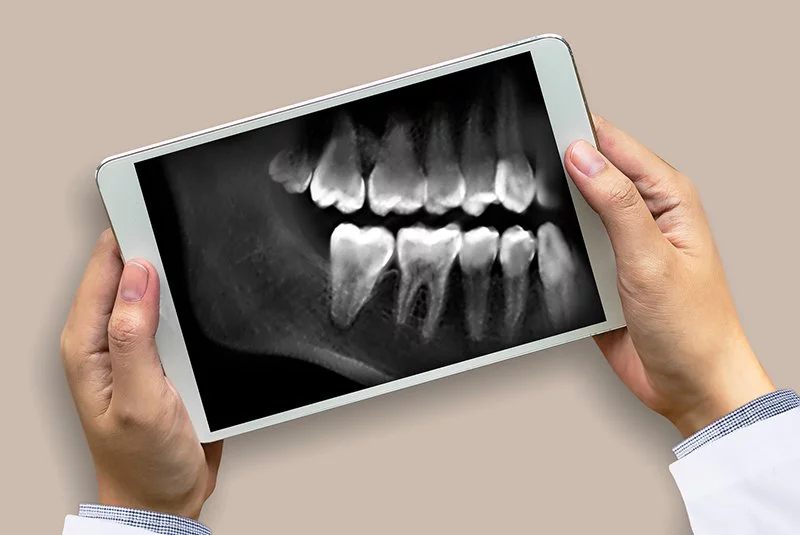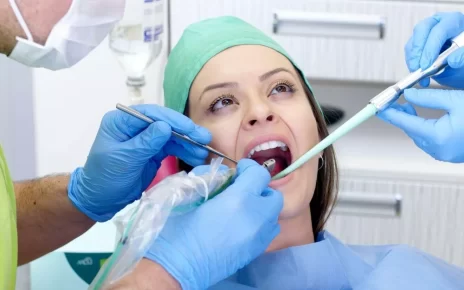An dentist or dental hygienist will put you under an apron made from lead to protect you from radiation exposure before asking you to sit or stand before their machine.
X-rays help dentists detect issues like tooth decay between teeth, impacted or unerupted teeth, jaw fractures and hard-to-catch cysts and abscesses; as well as issues like cleft palate or nasal abnormality.
Intraoral
X-rays give dental practitioners a comprehensive view of your skull and jaw, which allows them to detect cavities, identify abnormalities of bone and gum structures, as well as assess any unborn teeth that might emerge in future.
Digital radiographs allow dentists to more closely examine the teeth while remaining safe from traditional X-rays. While there is still some exposure, according to MedlinePlus it amounts to approximately 0.150 microsieverts for 18 radiographs taken as part of a full mouth X-ray series; this amount corresponds with what an airline passenger receives during a cross-country flight.
To take an X-ray, your dentist will place a bite block into your mouth and press down on it while your hygienist may wrap a thyroid collar around your neck to protect your thyroid gland. In order to achieve accurate results, patients must remain completely still; this may be difficult if you have a sensitive gag reflex or history of teeth grinding (bruxism).
Extraoral
These X-rays provide a more complete picture of your mouth, skull, and jaws than other X-rays can show, enabling them to detect problems that would be invisible with other images – extra teeth, tooth growth, fractured jaws, cleft palates as well as cysts, abscesses and solid growths may all be detected through them.
An X-ray uses special devices to secure your head during its taking, to avoid it moving and producing blurry images. Once taken, they need to be processed and developed similarly to photographic film; however this process is time consuming and uncomfortable for the patient.
Digital X-rays use an electronic sensor instead of film for quicker, more comfortable, and radiation-reducing X-rays that are instantly viewable on a computer screen, as well as adjustable to better show detail. According to MedlinePlus, digital X-rays boast higher accuracy than plain radiographs.
Panoramic
Panoramic x-rays capture an image of an entire mouth from ear to ear in one single image, using an x-ray generator rotating around your head and recording onto flat film or digital sensor. Chin, forehead and side rests are used during a scan for support during its entirety.
Dental professionals use panoramic images to locate fractured and impacted teeth, cysts or tumors, sinusitis, jaw abnormalities and bone loss, as well as issues like periodontal disease and tooth decay. The procedure is safe; low levels of radiation exposure will not increase health risks.
Greenwood notes that advancements in digital sensors, like autofocus sensors, can significantly enhance diagnostic quality and make these units valuable technology assets for practices. He advises practices to consider upgrading their panoramic system to include CBCT imaging in the near future; his team has proposed an algorithm based on multi-scale mathematical morphology which can enhance contrast, detail and edge enhancement of panoramic radiographs for contrast, detail and edge enhancement – this algorithm has been experimentally evaluated via metrics as well as clinically evaluated by dentists.
Bitewings
Bitewings show the crowns of both upper and lower teeth on either side of your mouth, helping your dentist detect decay between them as well as assess bone levels surrounding them. They should be taken at least once or twice each year.
As opposed to intraoral dental wings, bitewing radiographs offer superior detection of furcation involvement and caries as well as better characterizing alveolar bone loss. Furthermore, panoramic radiographs capture both bitewings and an extraoral full-mouth examination in one exposure for added efficiency and productivity within your practice.
Though bitewing x-rays expose patients to radiation, the dose is extremely low. To further minimize exposure, a thyroid collar and lead apron are used as protection measures against excessive radiation exposure. Pregnant women should not receive this type of x-ray due to potential harm that it could do their developing fetus; furthermore, knowing their gag reflex helps ensure the procedure can take place without discomfort for either party involved.





